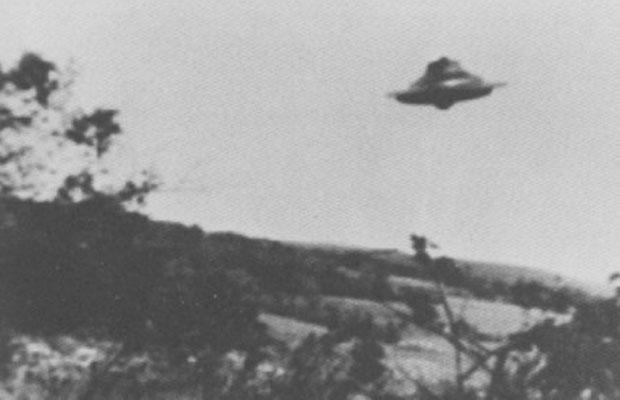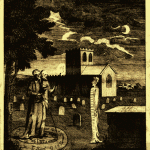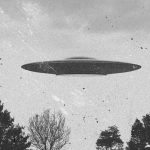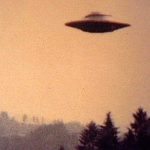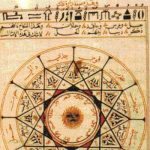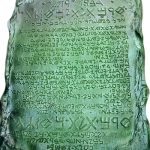We have seen how spiritualism and the belief in extra-terrestrial life grew up together in the nineteenth century, their belief systems entwining at times. Ishmael Reed, in his classic novel of voodoo in Harlem in the 1920’s, Mumbo Jumbo, defines a living mythology as the proper union of the text and its host. In this sense, we can think of spiritualism as a host, or phenomenon, in search of a text. Swedenborg, Rivail and Madame Blavatsky all attempted to produce a “text” for spiritualism. None were truly successful because the value of spiritualism is in the experience, not in any information derived from it. Spiritualism became an alternative form of religion, grafting a mythology onto its experience from both Eastern and Western sources.
With the beginning of the UFO era, a truly modern mythology emerged. The text came from science fiction and blended seamlessly with the host phenomenon to create a reality altering mythos of threatening and/or redemptive things in the sky. Myth, in its simplest form, can be considered a symbol and language construct that points to the deeper meaning beneath the surface of events. Myths are created by shaman, traditionally, and acted out in a ritual setting by the shaman’s culture. Despite all the unusual objects, including the airships, seen in the nineteenth and early twentieth century skies, no myth developed to explain them.
The shaman midwives at the birth of the new and very modern “flying saucer” myth were a magazine editor and a paranoid schizophrenic welder. Most studies of the UFO phenomenon ignore its ignoble beginnings as an occult fascination for morbid pulp fiction fans, preferring instead to focus on Kenneth Arnold’s initial sighting on June 24, 1947. After all, Arnold was a pilot, a reputable and responsible individual, while Ray Palmer and Richard Shaver were obviously cranks. But, at the time, the line between crank and serious observer was thin and indistinct.
The myth began to take shape at almost the same moment the Air Force released the first stories on “foo-fighters” in January 1944.
***
By late 1943, Ray Palmer, 33 year-old editor of the oldest science fiction magazine, Amazing Stories — founded by Hugo Gernsback in 1926 — had discovered an important marketing truth. Stories with Atlantis or Lemuria in their title made sales soar.
Lost Continent myths go all the way back to Plato and form an important sub-stratum of the flying saucer mythos. That this should be the case is curious, until we remember that Plato heard, second hand, his lost continent yarns from Egyptian sources. Egypt, as we noted earlier, retained knowledge from a planet-wide civilization, one engulfed by a cataclysm around 13,000 BC. In the nineteenth century, Ignastis Donneally produced two large best-selling volumes on Atlantis that became a part of occult folklore, influencing even Madame Blavatsky. Also, James Churchward’s series of volumes concerning Lemuria attained a small but significant following.
Most of this information would have been available to Amazing Stories’ readers. However, they wanted more. In the January 1944 issue, a letter from a war-plant welder in Barto, Pennsylvania, promised just that. Richard Shaver asserted that modern English had embedded within it the residue of an incredibly ancient language, possibly Atlantian or Lemurian. The key was something Shaver called the “Mantong” alphabet, a type of cipher for translating English letters into symbolic meanings. Shaver also claimed that his welding machines were telling him about his previous existence as a Lemurian.
Palmer encouraged him, and in the next few months Shaver produced a manuscript of sorts, written on odd scraps of paper, entitled “A Warning to Future Man” that claimed to be recovered race memories of life on the lost continent of Lemuria. In search of greater magazine sales, Palmer seized on the idea, and re-wrote Shaver’s rambling letter-warning into “I Remember Lemuria,” and “Mantong, the Language of Lemuria.” These appeared in the March 1945, issue of Amazing Stories.
Interestingly enough, Palmer chose to present these stories as fact. Just why is unclear. Palmer knew of Shaver’s history of mental illness, (eight years in the Pennsylvania State Hospital) and had crafted the fictional elements of Shaver’s stories himself. Yet, as truth they appeared, and, as truth, they bored deep within the collective unconscious of thousands of impressionable readers, creating the final component of the emerging mythos. Eighteen months later, when Kenneth Arnold spotted the disks flying past Mt. Rainier, a large segment of the popular consciousness was prepared. The text had found its host.
***
Turning the brittle yellow-brown pages of Amazing Stories today, The Shaver Mystery, as the fans labeled it, appears, all too obviously, a crudely crafted fake. Yet, somehow, the power of the archetypes linger. One hundred years of undefined sensory experiences and expert speculation on extra-terrestrial life had produced a critical amount of “gray area” reality. This zone of ambiguous experience cried out, psychically, for an explanation. When it came, however, the only shaman available were the crazies. Dr. Dee was a noted scholar, the Einstein of his era; Ray Palmer was a self-educated pulp fiction author, magazine editor and occult publicist. While the comparison does justice to neither, it does point up the fact that twentieth century science had become merely applied materialism. Science, like religion, had removed itself from the discussion.
Richard Shaver, however, was somewhat different. His symptoms are indicative of paranoid schizophrenia; voices from machinery, vast conspiracy plots, evil rays that cause bad things to happen, all of these are classic paranoid delusions. Edward Kelly, while perhaps lacking in conscience, is almost spectacularly sane by comparison. Shaver’s delusions are the dark and cloudy glass through which we see the myths at the end of history; his obsessions mirror the concerns of us all, and as we look into his private abyss, our fears and hopes as a species emerges out of the emptiness. Shaver’s work is not fact, it is not even true; it is real, in the way only the right myth at the right moment can be real.
Basically, Shaver tells us that 12,000 years ago a global civilization of giants, the Atlans, inhabited the earth. Their major continents were Atlantis and Lemuria, and they were the source of all the gods and goddesses of all ancient cultures. These creatures originally came from a large variety of other planets throughout the galaxy. A solar or stellar catastrophe occurred, and the inhabitants fled, all except those who had begun to mutate from the disaster. Some stayed behind and became humans. Others delved deep into the earth’s crust to avoid the harmful rays. Some of these, however, did not fare too well and eventually became a sub-species of corrupted and distorted monsters.
The “Deros,” or detrimental robots, as these evil dwarfs were called, had the power to read minds and drive people insane. All the evil and misfortunes of the world were their responsibility. However, a few Atlans survived without being corrupted. Called “Teros,” or integrative robots, these cave-dwellers helped humanity and struggled unceasingly against the Deros.
This all-encompassing dualistic world view offered both hope and fear to Amazing Stories’ readers. Hope, because irrational events actually had causes behind them, which turned to fear when it was realized that those causes were the sadistic pleasure of evil super-beings. The readers also responded to the “us versus them” quality of the mystery, with its hint of “secret knowledge” and vast conspiracies. By the end of 1945, Amazing Stories was selling 250,000 copies a month. Letters to the editor surged from forty or fifty a month to more than 2,500. Many reported sighting strange objects in the sky and meetings with Teros and Deros and other alien beings.
Shaver continued to crank out stories. They were now called stories, but the information was considered real, taken from the Lemurian thought archives. One year before Kenneth Arnold’s sighting, in the July 1946 issue, Palmer, in the introductory blurb to Shaver’s classic “Cult of the Witch Queen,” announced: “If you don’t think space ships visit the Earth regularly, as in this story, then the files of Charles Fort and your editor’s own files are something you should see.” Space ships were real, Palmer insisted, then without missing a beat, went on: “And if you think responsible parties in world governments are ignorant of the fact of space ships visiting the Earth, you just don’t think the way we do.”
All of this would be just a curious addendum to the history of imagination, except for what happened next. Palmer claimed the Shaver material was true; space ships filled with evil Deros, beneficent Teros and returning Atlans were real, not fantasy or wish-fulfillment. And then, for an incredible few weeks in the summer of 1947, it looked as if it were really coming true. The space ships had arrived.
***
In the spring of 1947, two years after the fall of Hitler’s Germany, the Western Allies and Soviet Russia glared at each other across “The Iron Curtain” of Churchill’s ringing phrase. The Cold War froze into place in March with the announcement of the Truman Doctrine pledging American aid, including military, to countries threatened by the communist menace. Behind all this lurked the planet destroying threat of atomic weapons.
Sporadic sightings had continued since the end of the ghost rocket flap, but the early months of 1947 were quiet. All that changed in late spring. In April, a professional weatherman, monitoring a balloon with a theodolite, tracked a disc shaped object through the skies above Richmond, Virginia. In May, a series of sightings, from Virginia to Colorado, briefly made the news. The first two weeks of June brought reports from Hungary of “silvery balls” hurtling through daytime skies, as well as sightings in Arizona and New Mexico.
Ten days before Kenneth Arnold’s sighting, a pilot named Richard Rankin spotted a flight of discs over Bakersfield, California. Rankin’s sighting did not make much of a news splash, but it is interesting because of the ambiguous nature of what happened next. Richard Rankin was one of the first people consulted by a pair of Air Force officers, Davidson and Brown, whose investigation and mysterious deaths added fuel to the fire of early UFO conspiracy speculation. Rankin was also an acquaintance of both Arnold and Ray Palmer. Just how all this fits together is only one of many mysterious loose ends running through this first month of the UFO era.
Next came the Maury Island affair. About two o’clock in the afternoon of June 21, 1947, a fisherman and his son spotted something unusual off Maury Island, near Tacoma, Washington. They claimed that six large doughnut shaped objects had hovered over the bay while one of the six spewed something like molten slag that damaged their boat, killed their dog and almost killed them. The fisherman, Harold A. Dahl, reported to his boss, Fred Lee Crisman, while his son was treated at the hospital. Crisman did not believe Dahl at first, but the samples of the space ship slag Dahl had collected helped convince him.
On the morning following his first bizarre encounter, Dahl was contacted by a man in a black suit, driving a black ’47 Buick, who warned him not to talk to anyone about what he had seen. Also that morning, Crisman claimed to have visited Maury Island to check on the slag and to have seen another similar ship himself. These reports would have a delayed effect on public opinion.
***
The first major outbreak of UFO hysteria started with Kenneth Arnold’s June 24 sighting. Arnold, a 32 year-old successful businessman, was flying toward Mt. Rainier, Washington, at 9,200 feet when he spotted a bright flash off in the distance. Looking over, Arnold saw “a chain of nine peculiar looking aircraft flying from north to south at approximately 9,500 feet elevation and going, seemingly, in a definite direction of about 170 degrees.” They were heading for Mt. Rainier at a high rate of speed, and every few seconds, one of them would dip or change directions, causing a bright flash of sunlight.
At first, it was hard for Arnold to determine size or shape. Then the objects flew past the summit of Mt. Rainier, and were outlined against the snow. Arnold would later draw them with rounded fronts, straight sides and rears that curved to a blunt point. He estimated they were fifty-feet long by a little less in width, and only three feet thick. Edge-on, they appeared to be a thin black line.
Arnold timed their flight from one familiar landmark to another. Later, when he measured the distance on a map, he found that the five mile long chain of objects had been flying at roughly 1,700 miles per hour. This was almost three times the speed of sound, and at that point, no earthly airplane had yet broken the sound barrier. Back at the airport in Pendleton, Oregon, Arnold asked his pilot buddies what they thought of his sighting. The conversation roamed from “foo-fighters” to guided missiles and secret prototypes of new weapons. Arnold decided to report his sighting, and headed off to the local FBI office.
By a simple twist of fate, the FBI office was closed. Arnold felt an obligation to report his sighting to somebody. Looking around, he spotted the office of the East Oregonian newspaper. Imagine the scene: A dusty western newspaper office, dark paneling and framed photos of politicians and celebrities, where a lone columnist is working late; in comes Gary-Cooper-esque pilot Kenneth Arnold with a very strange story. Arnold’s Idaho twang resonates softly through the late afternoon quiet as he tells his story, saying that the objects “flew like a saucer would if you skipped it across the water.” Columnist Nolan Skiff, intrigued, writes up the story. The next morning, the newspaper’s editor files the story with the national wire service.
“PENDLETON, Ore. June 25 (AP) — Nine bright saucer-like objects flying at “incredible speed” at 10,000 feet altitude were reported here today by Kenneth Arnold, Boise, Idaho, (a) pilot who said he could not hazard a guess as to what they were.”
The story went nation-wide in the next few days. Front page stories appeared on the “flying discs,” or “flying platters,” and, of course, “flying saucers.” Arnold’s solidly reputable background helped the story gain credibility, and for a week the country wondered over the Mt. Rainier sighting. Then, other sightings began to appear in print, and the flap was on. The flying saucer era had begun.
***
Ray Palmer quickly embraced the flying saucers and linked them to the Shaver Mystery. In the October 1947 issue of Amazing Stories, which went to press in early July, Palmer exulted: “A part of the now world-famous Shaver Mystery has now been proved! On June 25. . . mysterious supersonic vessels, either space ships or ships from the caves, were sighted in this country! A summation of facts proves that these ships were not, nor can be, attributed to any civilization now on the face of the Earth.”
The sightings continued:
*June 28 — Five or more bright discs flying in formation are seen by a pilot flying over Nevada.
*July 4 — Two groups of nine flat disks are spotted by a commercial airline pilot over Boise, Idaho.
*July 4 — Silvery objects fly over Portland, Oregon; witnessed by police and large groups of witnesses.
*July 7 — Patrolmen witness another spinning and spewing act by whirling donut-shaped craft off Maury Island, Tacoma, Washington.
*July 8 — White metallic ovoids and one thin disc do aerial calisthenics over Muroc AFB and Rogers Dry Lake, California.
*July 9 — Flat black intricately maneuvering disc seen by a pilot flying over Idaho.
*July 10 — Bright light ellipse spotted by a noted astronomer and his family in New Mexico.
In all, 125 sightings were reported in the month of June 14 through July 15. Almost a third came from Washington, with Colorado and Idaho next in number. The sightings over Muroc AFB on July 8, along with the report that same day of a crashed flying disc from Roswell, New Mexico, forced the Army Air Force to take action.
Early in July, classified orders were issued to treat all flying saucer reports as real and serious. Information was routed to the Technical Intelligence Division, Wright-Patterson Air Force Base, Ohio. There it became the responsibility of two intelligence officers, Capt. William Davidson and Lt. Frank M. Brown. As reports began to mount up in the first two weeks of July, the situation at TID was one of confusion bordering on panic. Memos flew thick and fast, asking for information concerning secret Soviet projects, the Navy’s discontinued disc-shaped craft, the XF5U-1, and speculating on an extra-terrestrial origin for the objects. TID was indeed taking the sightings very seriously.
Davidson and Brown began to interview witnesses to the sightings, starting with Richard Rankin, who later intimated to Kenneth Arnold that the Army knew much more about the discs than they were letting on. The Army, however, wasn’t the only group investigating the sightings. Ray Palmer and Amazing Stories were also on the job.
Palmer wrote Arnold early in July asking for information on his sighting. Arnold had never heard of Palmer or Amazing Stories, so he sent off a copy of his original account. Palmer responded with a letter giving Arnold the details of the Maury Island event and asking if Arnold would be interested in investigating it, with expenses paid by the magazine. As Arnold thought this proposal over, the two intelligence officers arrived.
Capt. Davidson and Lt. Brown had been given exclusive use of an A-26 bomber to pursue flying saucer reports. They flew into Boise and took Arnold out to dinner, pumping him for details and claiming that they had no idea what the objects might have been. They were even more delighted when Arnold announced that another witness, Capt. E. J. Smith, a commercial pilot, would be making a stopover in Boise that night. They could get a report on Smith’s sighting before they left to fly on to California. At the airport, the group ran into another witness, Dave Johnson, who had attempted to photograph a disc from his National Guard AT-6 transport plane. The intelligence officers took complete reports from all three men, but Arnold noticed that the officers seemed to have the basic information already, and were merely looking to confirm details.
Davidson and Brown had also gone through the piles of mail Arnold had received in the wake of the news reports on his sighting. They were most interested in queries from “societies and organizations.” Arnold doesn’t mention, in his published account, whether the intelligence officers suggested that he co-operate with Palmer in investigating the Maury Island event, but something happened to change his mind.
On July 29, Arnold flew from Boise to Tacoma, Washington. Along the way, he had his second sighting of flying discs. These were much smaller and flew somewhat slower than the first group. Arnold took movies of the objects; they showed up only as blurry specks on the film.
Checking into the best hotel in town, where he found a mysteriously pre-paid room waiting for him, Arnold lost no time in contacting Harold Dahl. In addition to his sighting story, Dahl now related his encounter with the man in the black suit. He seemed hesitant, even as he sat in Arnold’s hotel room, to tell his story. Dahl at first suggested that they all just forget about the whole thing and go home. Naturally, this made Arnold even more interested.
After going through his story, Dahl took Arnold to “his secretary’s house,” where a piece of the debris had been stored. This turned out to be rather ordinary looking volcanic rock. Dahl explained that his boss, Fred Lee Crisman, had the other more interesting pieces. Arnold decided to visit Crisman the next day. Crisman, who did not witness the first sighting, appeared to have a very unusual role in all of this. For one thing, Crisman was an avid reader of Amazing Stories and a believer in the Shaver Mystery. The year before, Crisman had written a letter to the magazine describing an epic confrontation and struggle with the underground Deros in tunnels beneath Puget Sound. It was Crisman who alerted Palmer to the Maury Island sighting; this in turn prompted the request for Arnold to investigate. And so, on the morning July 30, the story came full circle as Arnold sat down to interview Crisman.
Crisman told his story and offered to take Arnold out to Maury Island to collect samples of the debris. Even though Arnold had accomplished his immediate task of interviewing the witnesses and collecting samples, he still felt in need of help in making sense of it all. Arnold called on his friend Capt. Smith, who flew in to help. Both investigators questioned Dahl and Crisman at great lengths, but no holes appeared in their stories, and no new ideas developed.
That evening, the two pilots analyzed everything they had assembled on the Maury Island affair. They also discussed their own sightings and the possible connections between them. Some of Dahl and Crisman’s story seemed confirmed by another sighting on July 7. Similar craft had spewed cinders and ashes along a Puget Sound beach not far from Maury Island. Even with this partial confirmation, the two pilots were uneasy about the whole affair. It seemed inconsistent somehow.
Late that night, as the pair were wrapping up the conversation, a call came from the UP Bureau Chief in Tacoma, Ted Morello. Someone, it seemed was leaking the contents of their investigation and even their private conversations to the wire service. This shocked Arnold and Smith because they had carefully avoided the local press. The information, or at least some of it, could have come only from Dahl and Crisman. Even more interesting, some of the information could only have come froma “bug” in the hotel room. Arnold and Smith spent a tense hour searching the room for microphones, but failed to find anything.
The next day, more debris arrived, as did the intelligence officers, Capt. Davidson and Lt. Brown. The extra debris seemed as inconclusive as ever, and so the investigators asked the witnesses if they minded talking to the intelligence officers. Their reaction was interesting; Dahl wanted no part of an Army investigation, while Crisman appeared jubilant. Davidson and Brown were on the way, as the result of a phone call from Arnold. While they all waited in Arnold’s hotel room, a call came in from Ted Morello. He had the mysterious source of the night before on the phone, and wanted to confirm who was in the room at that moment. As both Crisman and Dahl were present, it appeared they were not involved.
Dahl left before the intelligence officers arrived. When they did, they seemed interesting only in giving Arnold and Smith their own new information, including a drawing the officers said came from a photograph they considered authentic. This image jogged Arnold’s memory; one of the craft he had seen had had this configuration. Conversation then turned to Crisman’s rendition of Dahl’s story. The officers seemed bored, and gave the debris only a cursory glance. They were not interested, period.
Crisman offered to run home and put together a sample of debris for the officers take back with them. They agreed, and then called for a car from McCord Air Force Base. They were flying back to California, even though it was after midnight. Arnold thought their excuse was thin, and that they gave the impression they believed the sighting was a hoax.
Just the officers were about to depart, Crisman raced up with a box full of debris, which was loaded into the vehicle. Arnold caught a glimpse of its contents, noting that it was similar to what they had seen, perhaps a little thicker with a more rocky surface. Davidson and Brown took off for the airfield, Crisman went home, and the two pilot investigators returned to their hotel room.
But the night wasn’t over yet. A call was waiting from Ted Morello. The mysterious informant had called back with the gist of the conversation with the intelligence officers. Stunned, the pilots discussed the almost supernatural quality of the surveillance until they drifted off to sleep.
Next morning, the pilots were up early for the trip out to Maury Island to look at more debris. Around nine thirty, the phone rang. It was Crisman, shouting excitedly that a B-25 had crashed and that “I think you and I know who was aboard that plane!” Overwhelmed, Arnold collapsed into a chair, as Smith rushed in from the bathroom to take the receiver. He turned white, hung up on Crisman, then called the airbase for confirmation. McCord AFB confirmed the crash and Ted Morello was able to supply a few more details. Still shaken, Arnold and Smith dressed and started to leave, only to run head long into Crisman.
They returned to the hotel room, but found that they had nothing left to say. The deaths hung in the air, smothering speculation. Eventually, Arnold began to think more clearly, and his thoughts turned to Ray Palmer. From the hotel room, Arnold called Palmer in Chicago and told him that the investigation was off. Palmer took it calmly, and warned Arnold not to take any fragments of the debris with him in his plane. Sound advice considering the B-25 crash. Before the call was over, Crisman asked to speak with Palmer. They spoke for a few moments, which Arnold found disturbing since Crisman had claimed not to know of Palmer the day before.
The morning paper carried the news in a banner headline: “Sabotage Hinted in Crash of Army Bomber at Kelso; Plane May Hold Flying Disc Secret.” In the next few days, as Arnold and Smith waited for the Army to contact them, Crisman disappeared. The mysterious source called back to announce that he had been whisked off to Alaska in an Army transport. McCord AFB confirmed a flight, of the same type and at the correct time, that matched the caller’s information. Nothing more has ever been heard from Fred Lee Crisman.
Eventually, an officer from McCord, a Major George Sander, arrived to collect the leftover debris samples. He left Arnold and Smith feeling unsettled and unsure. Had it been a hoax? Or some kind of intelligence operation? Arnold flew home on August 3, and almost crashed himself on the last leg of the journey.
The first classic case of the UFO era ended in confusion. Almost all the components of the UFO mythos can be found in the events of the first six weeks of sightings. This strange intersection of pulp fiction, serious observation and intelligence operations produced a kind of matrix around which the myth grew, like a seed crystal in a super-saturated solution.
More Articles from Sangraal.com:
Submit your review | |

